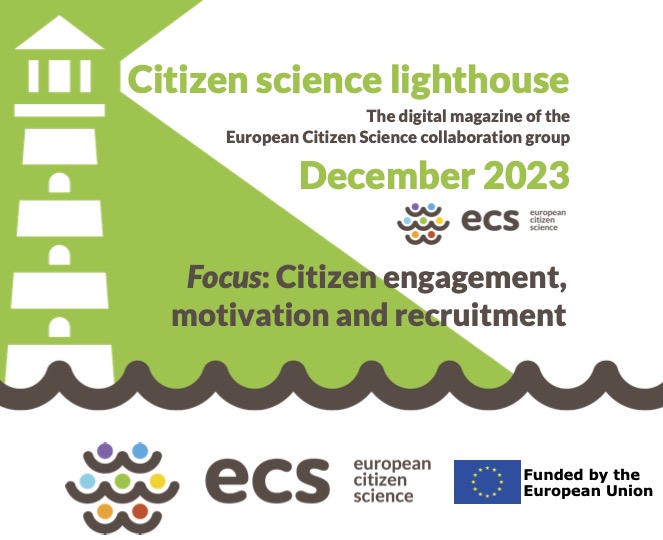
Citizen engagement, motivation and recruitment
Meritxell Martell
Dec. 1, 2023, 10:06 a.m.
Authors: Antonio Filograna, Meritxell Martell and Florence Gignac
Photo: Ars Electronica, Linz, Austria
Citizen scientists are undoubtedly the vital essence of any citizen science project. Therefore, keeping an eye on what interests and motivates the citizens, and what they expect from their involvement in the project, is crucial to ensure not only the success but also the sustained longevity of citizen science initiatives. Yet, maintaining consistent engagement and ensuring citizens remain highly motivated throughout can pose a challenge for many citizen science initiatives. On October 7th, Antonio Filograna from DECIDO and Meritxell Martell from RadoNorm organised a session, discussing strategies on how to engage citizens and, most importantly, keep them involved and motivated. This sparked some really interesting discussions and gave us some takeaways to think about.
There is no single set of most effective engagement tools and strategies, but those that are tailored to specific groups and leverage networks and communities prove to be powerful.
Before strategizing on how to engage citizens in a project, it is important to understand the type of participants you want to involve, as well as to be aware of their needs, motivations, and potential barriers to participation. In that case, a stakeholder mapping is always a good first step. Tools and strategies will highly depend on the target groups you aim to engage, which can range from announcements on TV shows and national news to newspapers, radio podcasts, social media campaigns, flyers, email invitations, etc. One strategy often overlooked is the power of the snowballing effect or word of mouth, which stands as an effective engagement strategy according to several members of the ECS Collaboration Group. This can be achieved by tapping into established community networks such as civil society organisations or local associations, attending their events and fostering collaborations. In RadoNorm, local libraries, local health authorities, word of mouth and the social media of local authorities have been crucial to recruit citizen scientists. Some groups have representatives and gatekeepers and their support can be harnessed and beneficial in spreading the word about the project. In the DECIDO project, a strategy to engage citizens was the Social Hackathon. This is nothing technical but, following the example of a hackathon, it involves various participants such as citizen organisations, businesses, NGOs, and policy makers who gathered together to brainstorm, analyse data, and ultimately find potential solutions to a problem, using the motto “Learn, discuss and then decide”. It is also important to note that the selection of engagement tools and strategies will significantly depend on the inclusivity objectives and ambitions you wish to address in your citizen science activities.
Yes, motivations for participation are very diverse - but overall, fun must be present!
After learning about projects from the ECS Collaboration Group, it is evident how motivations can significantly vary from one citizen to another and from one cultural context to another, even within a single project. Sometimes it is the desire to be part of something; other times, it is for personal reasons, such as acquiring new skills, or to enact change and contribute to evidence-based policymaking. Also, some seek to be recognized as equal stakeholders in policy changes. But ultimately, fun is a critical element in establishing and maintaining motivation. Participation should be enjoyable, especially considering that citizen scientists contribute during their leisure time without financial compensation. In this context, the adoption of a “gaming paradigm” fosters a sense of excitement among citizens, making their involvement more appealing and accessible. It transforms an otherwise daunting process into an enjoyable experience, attracting a wider range of citizens to actively participate.
Citizen scientists dropouts are entirely normal and should serve as a catalyst for researchers to self-reflect on the reasons why participants disengage.
Some level of dropout is natural in all projects. Instead of viewing this negatively, it can serve as an indicator of areas where the project may be lacking. There are different reasons for citizens to drop out. For instance, dropout rates can rise when citizen scientists lack trust or confidence in the project's activities and their potential impact. This can be attributed to the fact that citizens may not directly witness the results or outcomes of their contributions. This may indicate a lack of transparency in the project. To mitigate this, it is thus crucial to clearly communicate what the project aims to achieve in each of its steps, as well as its limitations, especially when unexpected changes occur. Ensuring that citizens are well-informed about what they are accomplishing is also very important.
Engagement is an ongoing effort and therefore, delegating efforts and adopting an adaptive approach to engagement strategies are key.
Engaging citizens extends beyond a single moment, such as the recruitment phase, and it requires researchers to sustain efforts to keep project activities relevant until the end. While juggling various roles, researchers need to be pragmatic and strategically plan their involvement with citizen scientists. Ensuring that a designated person is responsible for maintaining transparency and communication is important and this can be done by considering incorporating facilitation experts or dedicating an individual exclusively to engagement efforts. Above all, adopting an adaptive approach throughout the project in terms of engaging citizens, which continually aligns with evolving or changing motivations, is paramount. In fact, engagement might need to be tailored to the specific lifeworlds and life stages people are in. This can influence their preferred and possible ways of participating in the project.